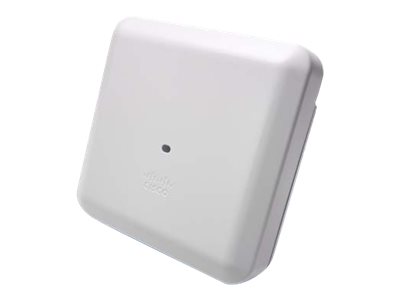
Most of the common issue that we are experiencing during the wireless optimization process is to find the optimal Tx power that will be configured on all Access Points.
As of today, we have many models of the Cisco Wireless Access Points but all of them have different Tx Power and Antenna gain parameters.
In all technical aspects, we could find the maximum supported Tx power (power level) but we don’t have any information about the maximum Tx power that is supported per channel.
As an example:
On 5Ghz UNII-1 channels, the maximum supported Tx power is 16dBm but on UNII-3 channels we could support up to 23dBm.
Configured Tx Power vs Real Tx Power (EIRP)
On our controllers, we can configure Maximum/Minimum Tx power that could be used by Access Points.
Configured Tx power applied only on the Access Point transmitter (without taking into the consideration antenna gain).
Cisco 2802i Antenna Specification

EIRP (Effective Isotropic Radiated Power)
EIRP is the actual amount of signal leaving the antenna and is a value measured in db and is based on 3 values:
a) Transmit Power (dBm)
b) Cable Loss (dB)
c) Antenna Gain (dBi)
To determine EIRP follow this equation:
<Transmit Power> – Cable Loss + Antenna Gain = EIRP
For example we have a Cisco access points running at full power with a 6dBi antenna on the 802.11a radio and a 2.5dBi antenna on the 802.11b/g radio.
802.11a EIRP = 17dBm (40mw) – 0dB + 6dBi = 23dBm = 200mw of actual output power
802.11bg EIRP = 20dBm (100mw) – 0dB + 2.5dBi = 22.5dBm = 150mw (approx) of actual output power
Tx Power Chart
CLI:
show advanced 802.11-abgn summary
show advanced 802.11a txpower

| Channels | Max Tx power dB | Allowed Power Levels 1-8 | |
| 2.4Ghz | 1 | 23 | 23/20/17/14/11/8/5/2 |
| 2 | 23 | 23/20/17/14/11/8/5/2 | |
| 3 | 23 | 23/20/17/14/11/8/5/2 | |
| 4 | 23 | 23/20/17/14/11/8/5/2 | |
| 5 | 23 | 23/20/17/14/11/8/5/2 | |
| 6 | 23 | 23/20/17/14/11/8/5/2 | |
| 7 | 23 | 23/20/17/14/11/8/5/2 | |
| 8 | 23 | 23/20/17/14/11/8/5/2 | |
| 9 | 23 | 23/20/17/14/11/8/5/2 | |
| 10 | 23 | 23/20/17/14/11/8/5/2 | |
| 11 | 23 | 23/20/17/14/11/8/5/2 | |
| Channels | Max Tx power dB | Allowed Power Levels 1-8 | |
| UNII-1 | 36 | 16 | 16/13/10/7/4/2/0/0 |
| 40 | 16 | 16/13/10/7/4/2/0/0 | |
| 44 | 16 | 16/13/10/7/4/2/0/0 | |
| 48 | 16 | 16/13/10/7/4/2/0/0 | |
| UNII-2 | 52 | 17 | 17/14/11/8/5/2/0/0 |
| 56 | 17 | 17/14/11/8/5/2/0/0 | |
| 60 | 17 | 17/14/11/8/5/2/0/0 | |
| 64 | 17 | 17/14/11/8/5/2/0/0 | |
| UNII-2 ext | 100 | 17 | 17/14/11/8/5/2/0/0 |
| 104 | 18 | 18/15/12/9/6/3/2/0 | |
| 108 | 18 | 18/15/12/9/6/3/2/0 | |
| 112 | 18 | 18/15/12/9/6/3/2/0 | |
| 116 | 18 | 18/15/12/9/6/3/2/0 | |
| 120 | NA | NA | |
| 124 | NA | NA | |
| 128 | NA | NA | |
| 132 | 18 | 18/15/12/9/6/3/2/0 | |
| 136 | 18 | 18/15/12/9/6/3/2/0 | |
| 140 | 16 | 16/13/10/7/4/2/2/0 | |
| UNII-3 | 149 | 19 | 19/16/13/10/7/4/2/0 |
| 153 | 23 | 23/20/17/14/11/8/5/2 | |
| 157 | 23 | 23/20/17/14/11/8/5/2 | |
| 161 | 23 | 23/20/17/14/11/8/5/2 | |
| 165 | 23 | 23/20/17/14/11/8/5/2 |
Available channels:
Not all the countries will support all the channels on both bands.
Please check your Regulatory Domain in link below:
https://www.cisco.com/c/dam/assets/prod/wireless/wireless-compliance-tool/index.html
Note:
The table above has been created based on Regulatory Domain A (Canada).
Reference:

